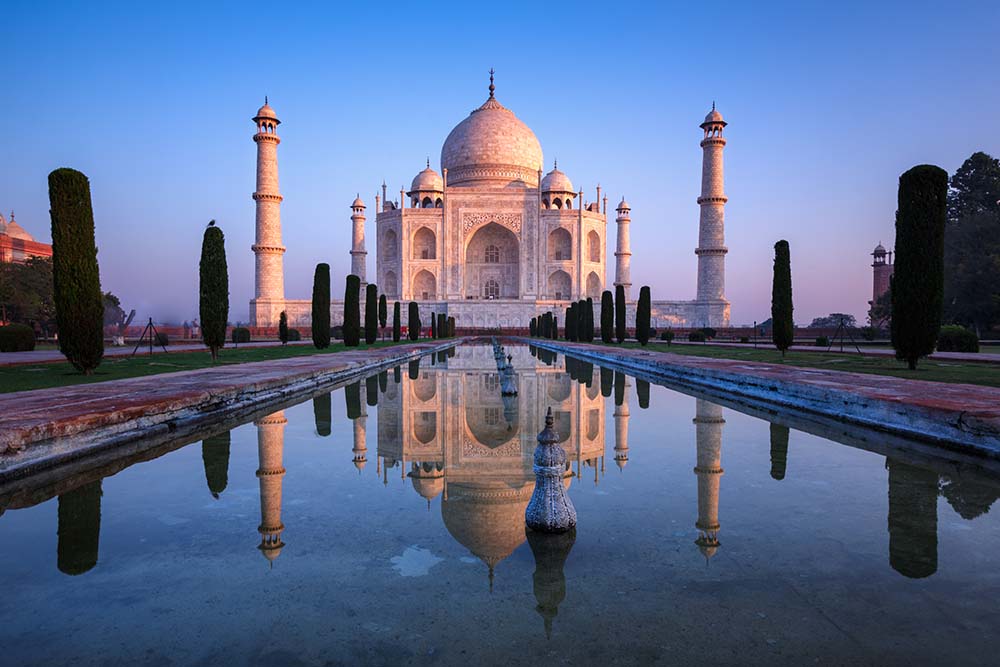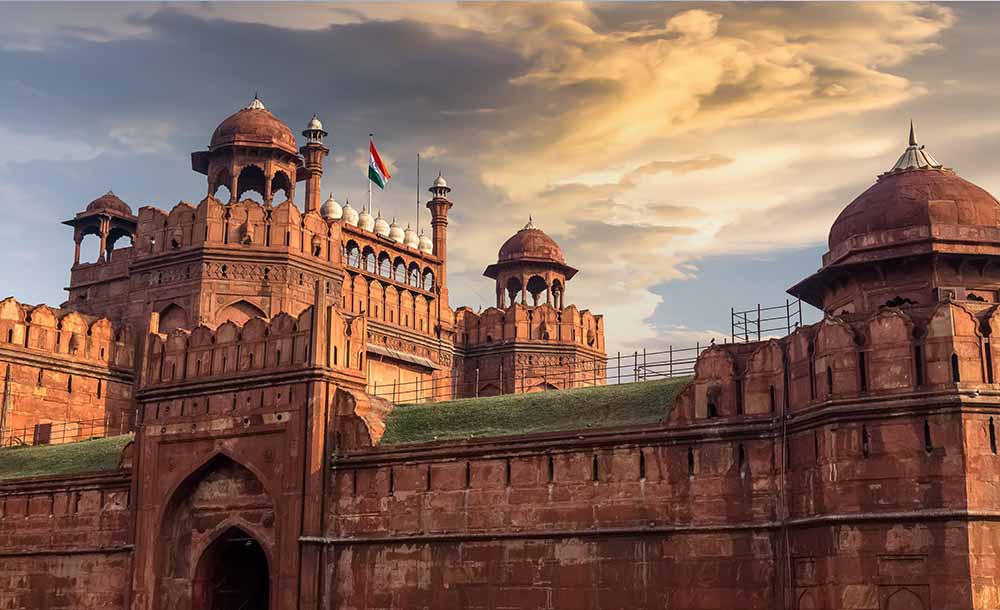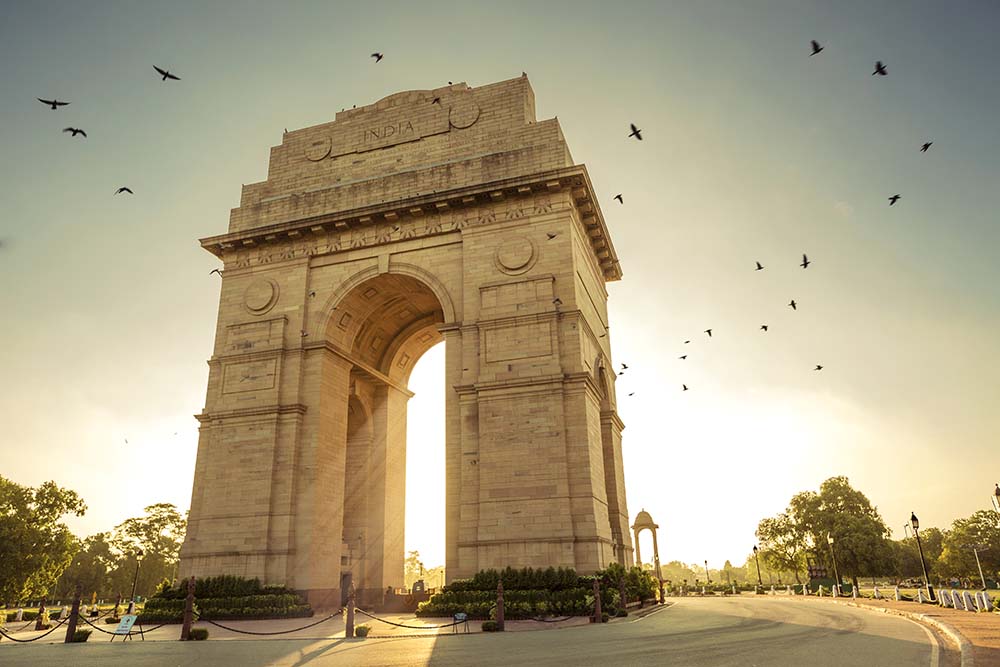The history of civilisation in India goes back more than 250,000 years, making it one of the world's oldest you should know that there are a lot of historical places in India with a lot of historical buildings and these historical buildings in India have a lot of rich history behind them.
India is one of the most diverse nations in the world, with over 6,000 languages spoken and numerous different cultures and faiths practised throughout the country.
As a result of India's extensive and varied history, the country is home to stunning architectural marvels.

The Taj Mahal
A UNESCO World Heritage Site, the Taj Mahal is a well-known landmark in the city of Agra. The Taj Mahal was built between 1631 and 1654 as a tomb for Empress Mumtaz Mahal, the wife of the reigning emperor Shah Jahan.
Intricate symmetry and lavish architecture are the hallmarks of the white marble edifice, which has a central dome surrounded by arches, lesser domes, and minarets.
Plant life and Koranic calligraphy adorn the Taj Mahal's interior in a way that is uniquely the Taj. The Taj Mahal is said to have required the labour of 20,000 people.
Although the Taj Mahal's main tomb is open to visitors, they are not allowed to explore the lower levels of the building. Additionally, there is the Taj Mahal's mosque and the enclave of the Jilaukhana private community in the immediate vicinity.
Qutub Minar
There was a reason why Qutub Minar was built: to commemorate northern India's first Muslim dominion.
Even though it's been almost 2,000 years since it was built, the iron pillar of this Indian historical monument hasn't corroded, making it even more fascinating.
The Qutub Minar celebration, usually in October or November, is the best time to visit. In the evening, don't miss the light display.
Many of the religious and cultural monuments and structures that make up the Qutub Complex in Delhi date back to the Slave Dynasty. The Mehrauli, or Lal Kot, was erected in 1060 by the Tomar Rajput monarch, Anang Pal, and is today known as the Qutub Complex.
The Might of Islam Mosque was one of the earliest structures built as part of the Qutub Complex. A historic iron pillar at the mosque's heart dates from the fourth century AD, according to historians.

The Red Fort
Imperial India's Shah Jahan erected Delhi's Red Fort in 1639 when the capital was relocated from Agra to Delhi. The Red Fort, so named because of the red sandstone bricks that form its protective walls, was constructed as Shah Jahan's royal castle and as a strategic building.
The Red Fort's walls rise up to 33 metres in sections and have artistic carvings, domes, and minarets, making it an intimidating spectacle. There are several more structures in the Red Fort Complex, including the Red Fort itself as well as the Salimgarh Fort.
The huge scale, beautiful proportions, and architecture of India's Red Fort all symbolise a time of unfettered extravagance. A decade was required to accomplish this. While initially composed of limestone, the fort's paint began to wear off during the English administration, so they decided to paint it red.

Hawa Mahal
The Hawa Mahal is one of the world's highest free-standing structures. Despite its curved design, its pyramidal form ensures that it remains stable. The 953 small windows of this monument are noted for their delicate latticework. There's no doubt that it's an impressive piece of art at first glance.
The Maharaja Sawai Pratap Singh erected Jaipur's Hawa Mahal, or Palace of the Winds, in 1799. Hawa Mahal's red sandstone facade rises into a curved shape, making it an eye-catching building.
Hawa Mahal's vast lattice of 935 small windows is perhaps one of its most striking characteristics. Women at Hawa Mahal may see outside while yet being modest because of the design of these windows. A purdah was in place at the time, which meant that women had to stay covered.
Victoria Memorial
The Victoria Memorial Hall in Kolkata, West Bengal, is one of India's most renowned tourist destinations. The Prince of Wales placed the foundation stone for the monument in 1906, and it has stood ever since. The Queen's legacy lives on via the Victoria Memorial Hall, which was erected in her honour.
The Victoria Memorial Hall in Kolkata is now regarded as one of the city's best art museums. The hall, in addition to serving as a monument, also honours the British Empire's achievements in India. The hall's Indo-Saracenic revivalist design was created by William Emerson. British and Mughal influences are evident in the design. With a total area of 64 acres, it's one of the largest memorials in the world.
All those looking to relive British history should make a point of visiting Victoria Memorial Hall. There are several portraits and effigies of notable Indians who have made significant contributions to the country's history and culture. Kolkata's most popular tourist destination attracts visitors from all over the globe.
Konark Temple
The Konark Sun Temple, a World Heritage Site, is situated in the Puri district of Orissa and is the town's most famous landmark. The temple was constructed in the 13th century by King Narasimhadeva I of the Eastern Ganga Dynasty.
It has the form of a huge chariot and is supported by twenty-four chariot wheels. The temple is dedicated to the Sun God.
The Sun God is the focus of this temple's construction. A sundial is located at the base of the structure, and each of the 12 wheels contains an accurate timepiece. This temple stands out in the form of a giant chariot.

India Gate
The India Gate, a monument commemorating the 90,000 Indian troops who died in the North West Province of Afghanistan during World War I and the Afghan Conquest of 1919, is located on Rajpath, one of Delhi's most renowned boulevards.
The arch's exterior height is 136 feet, while its interior height is 87 feet, 6 inches. It is made of sandstone and stands 160 feet tall. New Delhi's India Gate is also known as the city's first gate. For those who served, their names are etched on its walls, along with an everlasting light named the Amar Jawan Jyoti.
The Duke of Connaught laid the foundation stone for the memorial in 1921, and the monument was dedicated to the country by Lord Irwin ten years later. After India earned its independence, the Amar Jawan Jyoti was erected to the monument as a tribute to the fallen troops of the December 1971 Indo-Pak War.
Some other historical places in India to visit are:
The Great Living Chola Temples, Tamil Nadu
The Chola kingdom built Brihadeshwara, Airavateshwara, and GangaikondaTemples. Artistic and architectural quality is evident in each and every one of these works, which represent The Chola Empire's exceptional accomplishments in sculpting, building, painting, and bronze casting are exceptional.
The Hampi Ruins, Karnataka
History buffs and art admirers will have a field day in this locale. Beautiful constructions and sculptures adorn the site, which also serves as the site of the first known human habitation, dating back to the first century CE.
The Mysore Palace, Mysore, Karnataka.
This castle seems to have stepped straight out of a storybook, such are its size and splendour. Ornate ceilings and exquisite designs embellish the palace's interiors. One may find jewel-encrusted hallways and stained-glass windows as well as open mandaps in the palace. The Dussehra celebration is the ideal opportunity to pay a visit to the magnificent palace.
The Charminar of Hyderabad, Telangana
To commemorate the end of the city's epidemic, Charminar was constructed with a cat's head atop one of its arches to ward off vermin that once threatened to wipe out Hyderabad.
The almost 20-meter-tall minar pillars that support this structure are what give it its name. Because of the tunnel that connects it to Golconda Fort, it's regarded as both beautiful and intriguing.
Gateway Of India, Mumbai
This is one of the world's most recognisable monuments. While it was originally created as a point of entrance and departure for British colonists, it has now become a popular picnic area for both residents and visitors.
Madhya Pradesh's Gwalior Fort
One of the country's most impregnable forts may be found here. A tumultuous and extensive history may be traced all the way back to the year 525 AD. You won't want to miss the music and light spectacle when you visit this monument, which is both beautiful and fascinating.
The Sanchi Stupa in Madhya Pradesh
The stupa at Sanchi epitomises the majesty and reverence of Buddhist architecture at its finest. In the dome-shaped construction of the stupa, Lord Buddha's remains have been preserved for centuries.
The stupa's elaborate sculptures, which rise to a height of 54 feet, portray the story of Lord Buddha's life.
FAQS
What are the most well-known structures in India?
Among India's best-known historical landmarks are the Taj Mahal and the Qutub Minar, as well as the India Gate and the Gateway of India.
Which Indian state has the most historical landmarks?
The state of Uttar Pradesh has the most monuments in India, totalling 3,685. As a result of its cultural and historical significance, the region is referred to as the 'heartland of India.'
Which Indian city is well-known for its historical monuments?
Agra, Uttar Pradesh's most populous city, is a popular tourist destination owing to its many world-renowned monuments. The Taj Mahal, Agra Fort, Fatehpur Sikri, Lalbagh, etc. are the most popular attractions here.